GATE 2023 Geomatics Engineering Question Paper PDF is available here for download. IIT Kanpur conducted GATE 2023 Geomatics Engineering exam on February 11, 2023 in the Afternoon Session from 02:30 PM to 05:30 PM. Students have to answer 65 questions in GATE 2023 Geomatics Engineering Question Paper carrying a total weightage of 100 marks. 10 questions are from the General Aptitude section and 55 questions are from Core Discipline.
GATE 2023 Geomatics Engineering Question Paper with Solutions PDF
| GATE 2023 Geomatics Engineering Question Paper with Solutions | Check Solutions |

“You are delaying the completion of the task. Send ______ contributions at the earliest.”
References : ______ : : Guidelines : Implement
(By word meaning)
In the given figure, PQRS is a parallelogram with PS = 7 cm, PT = 4 cm and PV = 5 cm. What is the length of RS in cm? (The diagram is representative.)

In 2022, June Huh was awarded the Fields medal, which is the highest prize in Mathematics.
When he was younger, he was also a poet. He did not win any medals in the International Mathematics Olympiads. He dropped out of college.
Based only on the above information, which one of the following statements can be logically inferred with certainty?
A line of symmetry is defined as a line that divides a figure into two parts in a way such that each part is a mirror image of the other part about that line.

The given figure consists of 16 unit squares arranged as shown. In addition to the three black squares, what is the minimum number of squares that must be coloured black, such that both \(PQ\) and \(MN\) form lines of symmetry? (The figure is representative)
Human beings are one among many creatures that inhabit an imagined world. In this imagined world, some creatures are cruel. If in this imagined world, it is given that the statement “Some human beings are not cruel creatures” is FALSE, then which of the following set of statement(s) can be logically inferred with certainty?
(i) All human beings are cruel creatures.
(ii) Some human beings are cruel creatures.
(iii) Some creatures that are cruel are human beings.
(iv) No human beings are cruel creatures.
To construct a wall, sand and cement are mixed in the ratio of 3:1. The cost of sand and that of cement are in the ratio of 1:2.
If the total cost of sand and cement to construct the wall is 1000 rupees, then what is the cost (in rupees) of cement used?
The World Bank has declared that it does not plan to offer new financing to Sri Lanka, which is battling its worst economic crisis in decades, until the country has an adequate macroeconomic policy framework in place. In a statement, the World Bank said Sri Lanka needed to adopt structural reforms that focus on economic stabilisation and tackle the root causes of its crisis. The latter has starved it of foreign exchange and led to shortages of food, fuel, and medicines. The bank is repurposing resources under existing loans to help alleviate shortages of essential items such as medicine, cooking gas, fertiliser, meals for children, and cash for vulnerable households.
Based only on the above passage, which one of the following statements can be inferred with certainty?
The coefficient of \(x^4\) in the polynomial \((x-1)^3(x-2)^3\) is equal to _____.
Which one of the following shapes can be used to tile (completely cover by repeating) a flat plane, extending to infinity in all directions, without leaving any empty spaces in between them? The copies of the shape used to tile are identical and are not allowed to overlap.
An angle was measured with a standard error of 5". How many observations a surveyor needs to take in order to obtain a standard error of 1" for the mean value of this angle?
What are the Manhattan and Pythagorean distances (in m), respectively between points A and B in the figure below, where the Euclidean distance between A and C is 4 m, and the Euclidean distance between C and B is 4 m? All the cells have the same edge lengths.

Which of the following is tested using the Chi-square test in least squares adjustment?
In active remote sensing of Earth objects from a satellite-borne sensor, the source of the energy used for sensing, lies at the }.
For a push-broom sensor, the following details are given:
Number of detectors \(=3000\)
Height above the ground \(=900~km\)
Swath on the ground \(=30~km\)
The spatial resolution of the sensor is \hspace{1.2cm} m.
To visually distinguish between a river channel and a canal on an image, having similar widths and located in the same area, the most important parameter used is \hspace{2cm}.
The unit of spectral radiance is ____________.
The ratio between the reflected to the incident energy on a surface at a particular wavelength gives the __________ of the surface.
GNSS stands for Global Navigation Satellite Systems. As of today, which of the following is the complete set of GNSS constellations that cover the entire globe?
The basic premise for using the DGPS technique is to reduce the errors due to
The orbital period of GPS satellites is determined by the _______ of their orbits.
Which vector data analysis tool combines geometries and attributes from different layers?
A GIS analyst has two raster datasets with the same number of rows and columns. The analyst computes the average of the two input raster layers to generate a new raster layer with the same size as the input raster layers. What type of raster data analysis operation is performed?
Match the following errors (Column 1) in spatial data digitization with their descriptions (Column 2).
Column 1 Column 2
(P) Mis-located entities 1) Points, lines or boundary segments digitized twice
(Q) Missing labels 2) Points, lines or boundary segments digitized in wrong place
(R) Artefacts of digitization 3) Undershoots, overshoots, wrongly placed nodes, loops or spikes
(S) Duplicate labels 4) Undefined polygons
(T) Duplicate entities 5) Two or more identification labels for same polygon
Which of the following statement(s) is/are TRUE for the least squares adjustment of observations?
Which of the following statement(s) is/are TRUE for the systematic errors?
In the following figure, A and B are fixed points with known plane rectangular coordinates. C and D are the new points in the control survey whose coordinates are to be determined. For this network, the surveyor has measured all 8 internal angles (1 to 8) and 5 sides BC, CD, DA, AC and BD. The value of redundancy (r) for the given figure will be equal to _________ (In integer).

As shown in the following figure, let \(d_1, d_2, d_3\) denote three uncorrelated clockwise directions, observed at point \(P\) with equal standard errors for each direction, i.e., \(\sigma_{d_1}=\sigma_{d_2}=\sigma_{d_3}=\pm\sqrt{2}''\). Let \(\alpha_1\) and \(\alpha_2\) be two included angles formed by these three directions. The covariance matrix (in arcsecond\(^2\)) for these included angles will be given as:

The figure shows three distance observations \(D_1\), \(D_2\) and \(D_3\). The table lists values of these observations and the corresponding weights. Assuming uncorrelated observations, the most probable values by the least squares approach for these measurements are __________ (Rounded off to 3 decimal places).
Distance & Measurement (m) & Weight
\(D_1\) & 40.150 & 1
\(D_2\) & 40.180 & 2
\(D_3\) & 80.390 & 1

Which of the following methods is widely used by the GNSS constellations to distinguish the satellites from each other at the GNSS receiver?
For the following data, the slope \((m)\) and intercept \((c)\) of the least squares fitted straight line \((Y=mX+c)\) are given as:

Which of the following statement(s) is/are CORRECT for sun-synchronous Earth observation satellites?
Which of the following statement(s) is/are CORRECT?
The spectral reflectance curves of three materials (A, B, and C) are shown, along with three wavelength bands X, Y, Z. Which of the following statement(s) is/are CORRECT?

Which of the following statement(s) is/are TRUE?
In the network shown below, after converting it to a topological graph, which of the following statement(s) is/are TRUE? (Assume there are no pseudo-nodes)

Which of the following type(s) of tolerances is/are used in editing GIS data?
Choose the CORRECT statement(s) regarding microwave remote sensing.
Consider the Sun and the Earth as blackbodies at \(6000~K\) and \(300~K\) temperatures, respectively. Which of the following statement(s) is/are INCORRECT?
Which of the following statement(s) concerning GNSS errors is/are CORRECT?
For a push-broom (along-track) sensor the following are known:
Field of view (FoV) = 2 degrees
Instantaneous FoV = 1 milli-radian
Time to scan one full scanline = \(2\times 10^{-2}\) s
Height above ground = 100 km
The dwell time for a single pixel of this sensor is ___________ s. (Rounded off to 2 decimal places)
The range accuracy with a microsecond accurate clock in the GNSS receiver is about 300 m. If we improve the clock accuracy to \(3.33\times 10^{-x}\,\)s, the range accuracy becomes 1 cm. The value of \(x\) is _____ (In integer).
Assume the speed of light to be \(c=3\times 10^8\) m/s and that no other errors are being considered.
Hint: error-free range = speed of light \(\times\) time of travel of the signal
A GPS satellite is flying at a distance of 20,000 km from the observer. The phase of the L1 carrier (1575.42 MHz) in degrees as received by the observer is _____ (Rounded off to 2 decimal places).
Assume that the signal did not experience any refraction, reflection or other errors and the speed of light to be \(c=3\times 10^8\) m/s.
For a profile given in the figure in the form of three steps A, B and C, the following information is available:
Height of step A (\(H_A\)) with respect to a reference line = 10 m (known and error free)
Difference in height between step A and step B (\(h_1\)) = 5 m \(\pm\) 2 mm
Difference in height between step B and step C (\(h_2\)) = 8 m \(\pm\) 3 mm
\(H_B\) and \(H_C\) are the unknown heights of step B and C, respectively. The step B is higher than step C and D.
The coefficient of correlation, \(\rho_{h_1 h_2}\), between the height differences = 0.25
The coefficient of correlation between estimated heights of points B and C (\(\rho_{H_B H_C}\)) will be __________ (Rounded off to 2 decimal places).

The relative radiance value of a facet of a Triangulated Irregular Network (TIN) can be computed using: \[ R_f=\cos(A_f-A_s)\sin(H_f)\cos(H_s)+\cos(H_f)\sin(H_s) \]
Where, \(R_f\) is the relative radiance value of a facet, \(A_f\) is the facet’s aspect, \(A_s\) is the sun’s azimuth angle, \(H_f\) is the facet’s slope and \(H_s\) is the sun’s altitude. Suppose a facet of a TIN has a slope value of \(10^\circ\) and an aspect value of \(297^\circ\) and sun’s azimuth of \(315^\circ\). For sun’s altitude angle of \(65^\circ\), the relative radiance value of this facet is ______ (Rounded off to 2 decimal places).
The table provides the X- and Y-coordinates of the points, measured in row and column of a raster with cell size of 1 meter, and their known values. Using inverse distance weighted (IDW) interpolation method and Euclidean distance, the interpolated value at Point 0 is ______ (Rounded to 2 decimal places). A constant rate of change in value between points should be assumed.

| Point | X | Y | Value |
|---|---|---|---|
| 1 | 69 | 76 | 27 |
| 2 | 59 | 67 | 10 |
| 3 | 74 | 79 | 13 |
| 0 | 69 | 67 | ? |
The bearing of the line \(AB\) from North is \(143^\circ 40'\) and angle \(ABC\) measured in clockwise direction is \(309^\circ 30'\). The bearing of line \(BC\) in Quadrantal Bearing System is \hspace{2cm.
Which of the following map scale is most suitable for urban planning?
Which of the following statement is NOT true regarding relief displacement in vertical photographs in the context of aerial photogrammetry?
A square grid is laid on a flat terrain and is photographed from an aerial camera. The flying height and camera parameters are assumed to be constant. The camera and lens are assumed to be perfect (i.e. free from any distortions). The image of the grid obtained from the camera is shown below. Select the CORRECT statement from the statements given below.

Which of the following statement is TRUE for the World Geodetic System 1984 (WGS84)?
Which of the following map(s) is/are published by Survey of India?
Which of the following triangles are well conditioned and may be suitable for control establishment using triangulation?

An angle of \(90^\circ\) is to be laid out with a theodolite having a least count of \(30''\). The angle was measured by repetition method and was found to be \(90^\circ\,00'\,25''\). The offset value at a distance of \(300\) m from the theodolite to set out the correct angle is ______ m. (Rounded off to 3 decimal places).
The following vertical circle readings were taken by a theodolite set up at station A to observe targets located at P and Q. Find the vertical angle \(PAQ\).

An aerial photograph is to be taken from a flying height of \(2~km\) above a flat ground with a camera having a focal length of \(200~mm\). The image format used is \(23~cm \times 23~cm\). The ground area covered by a single photograph is \hspace{1.6cm \(km^2\).
The scaled and rotated versions of vectors [1, 2] and [-3, 4] are _____.
Find the best match between Column 1 and Column 2
Column 1
P: Trilateration
Q: Triangulation
R: Traversing
S: Resection
Column 2
1. Measurements of lengths and directions of all sides
2. Measurements of all the sides of a triangle
3. Measurements of all the interior angles of a triangle
4. Determination of occupied position with the help of known stations
Which of the following statement(s) is/are CORRECT?
For a constant flying height, the average scale of an aerial photograph depends on which of the following parameter(s)?
Which of the following statement(s) is/are CORRECT?
Following is the page of a field book used for levelling. Few readings marked with ‘-’ are illegible. The Reduced Level (RL) of the Temporary Bench Mark (TBM) is ______ m (Rounded off to 2 decimal places). All the readings are in m.

The zone number of Universal Transverse Mercator (UTM) projection having a longitude of \(67^\circ 20' 30''E\) is \hspace{1.2cm (In integer).
A pair of overlapping vertical photographs were taken from a flying height of \(1230~m\) above sea level with a camera having a focal length of \(152.4~mm\). The distance between the consecutive exposure stations is \(350~m\). The parallax bar reading of a point A on the photograph is observed as \(10.96~mm\). The parallax bar constant for this setup is given as \(80.71~mm\). The elevation of point A above sea level is \hspace{1.8cm m (Rounded off to 2 decimal places).
A perfectly adjusted tacheometer is set at a point A having Reduced Level (RL) of 80.50 m and the following readings are taken to the staff held at point B having RL of 80.10 m.

The height of the instrument from the ground above point A is \hspace{1.8cm} m (Rounded off to 2 decimal places).
The purpose of thresholding in supervised classification is
The pixel values for a 3 band and 8-bit image are (127, 127, 127). On an RGB colour display, this pixel will appear __________.
The value at the center pixel of the image at (1) obtained after applying the filter given at (2) is ________.

To store a 3 band, 4-bit, \(512\times512\) size image (without header) the number of storage bits required are ________.
A child travelling in a bus is staring at the wheels of a car. To the child’s amusement the car wheels appear to spin backwards, but the car moves forward. This perception is because of the nature of our human visual sensory system, and is attributed to ________.
Which one of the following is NOT a linear operation?
The minimum number of 2-dimensional ground control points (GCPs) required for second-order polynomial mapping for image georeferencing is:
Consider an across-track multispectral scanner with ground pixel size of \(56\,\)m \(\times\) \(79\,\)m in the along-track and across-track directions. Which of the following statement is TRUE?
The contingency table below is obtained after an image classification. The overall classification accuracy (\(O\)) is given as

Divergence analysis in classification is used:
Consider the histogram of an 8-bit image given below at (1). A piece-wise linear contrast stretch given at (2) is applied on the said image. The minimum and maximum pixel values of the image obtained after applying the given contrast stretch are _______ (minimum value) and _______ (maximum value), respectively.

The variance–covariance matrix for a 3-band image is given below (bands in the order 1, 2, 3). Which of the statement(s) is/are CORRECT?
\[ \Sigma=\begin{bmatrix} 9 & 2 & 4
2 & 9 & -3
4 & -3 & 9 \end{bmatrix} \]
Which of the following statement(s) is/are TRUE regarding color theory:
Pixel \((x,y)\) indicates a pixel at location \(x,y\) in the image coordinate system. Which of the following statement(s) is/are CORRECT?
Which of the following statement(s) is/are CORRECT in the context of image enhancement?
The value of the convolution of \(f(x) = 3 \cos 2x\) and \(g(x) = \frac{1}{3} \sin 2x\) where \(x \in [0, 2\pi]\), at \(x = \frac{\pi}{3}\) is __________ (Rounded off to 2 decimal places).
A sensor converts the influx of light linearly to digital code through voltage changes. The sensor has a voltage range of 0-5 V and the maximum number of codes that it can quantize the voltage change is 2048. The bit-size of the quantizer is __________ (In integers).
The following digital numbers are given for a pixel of multispectral sensor. The NDWI (normalized difference water index) for this pixel is __________ (Rounded off to 1 decimal place).
In the grid below, the four corners A, B, C and D are the pixel locations on an image. The brightness values at pixels A, B, C and D are 10, 20, 5 and 30, respectively. Using bilinear interpolation, the brightness value determined at point P is _______ (Rounded off to 1 decimal place).

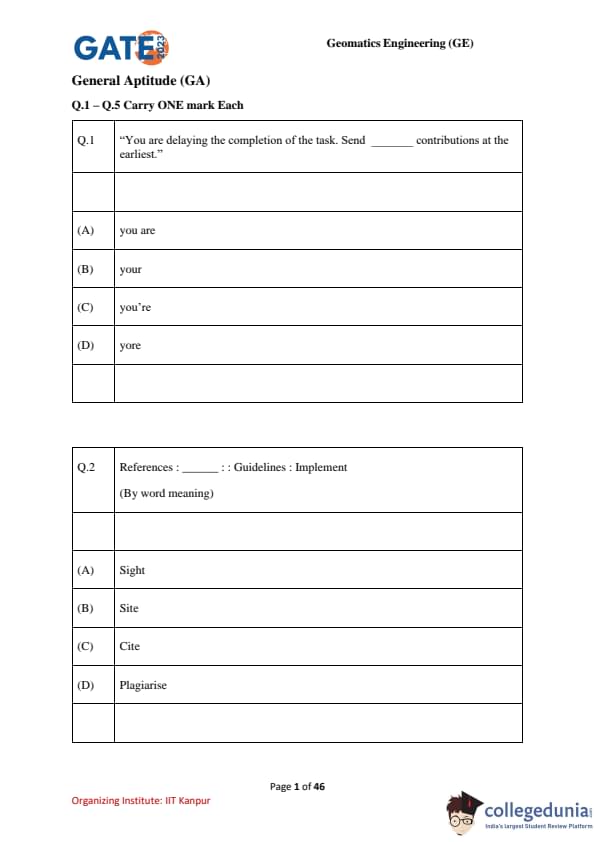

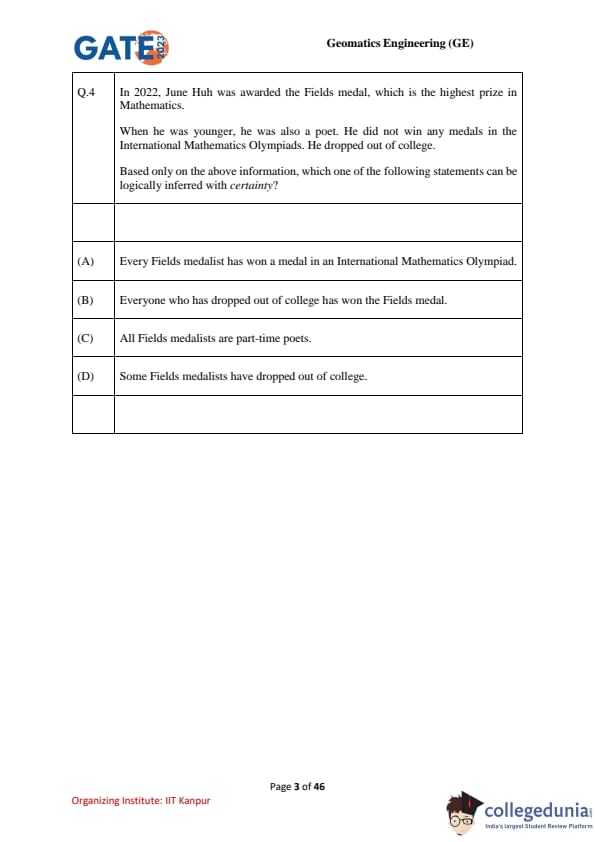
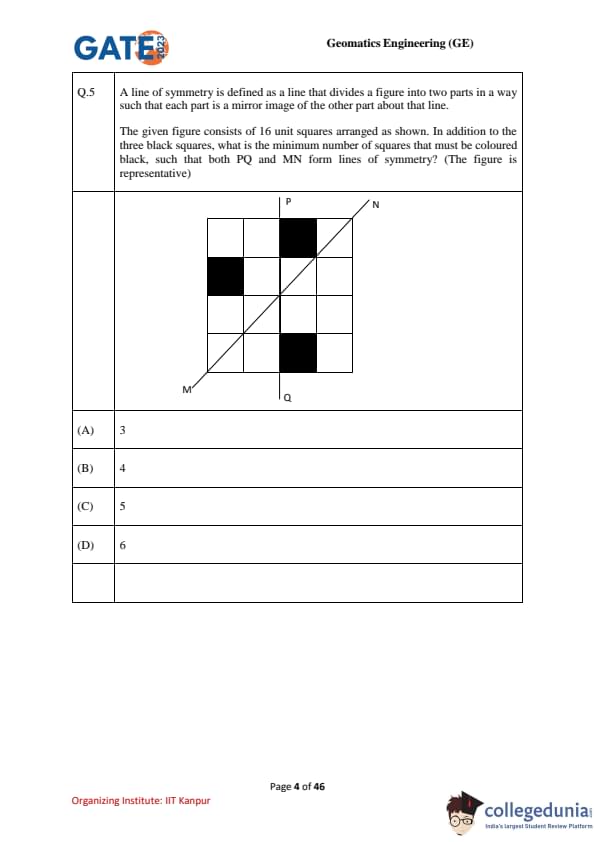
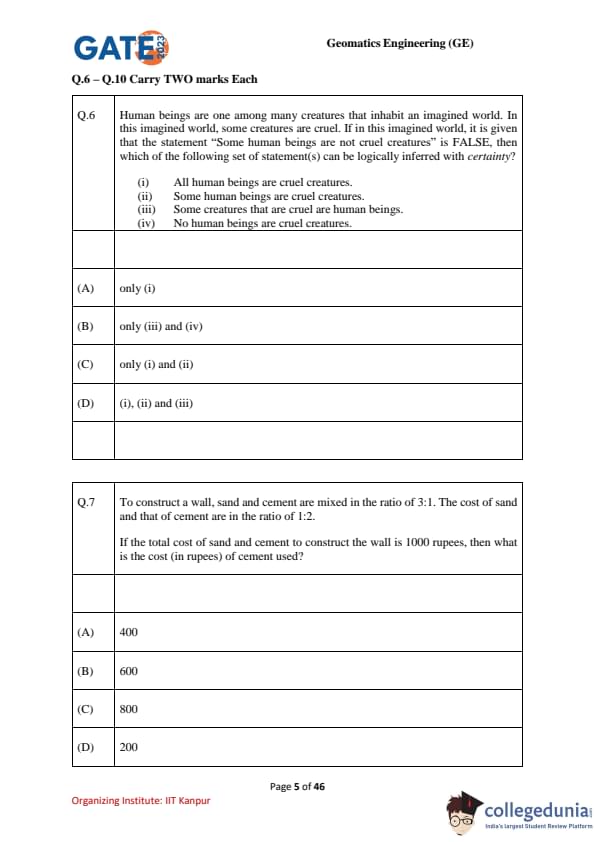

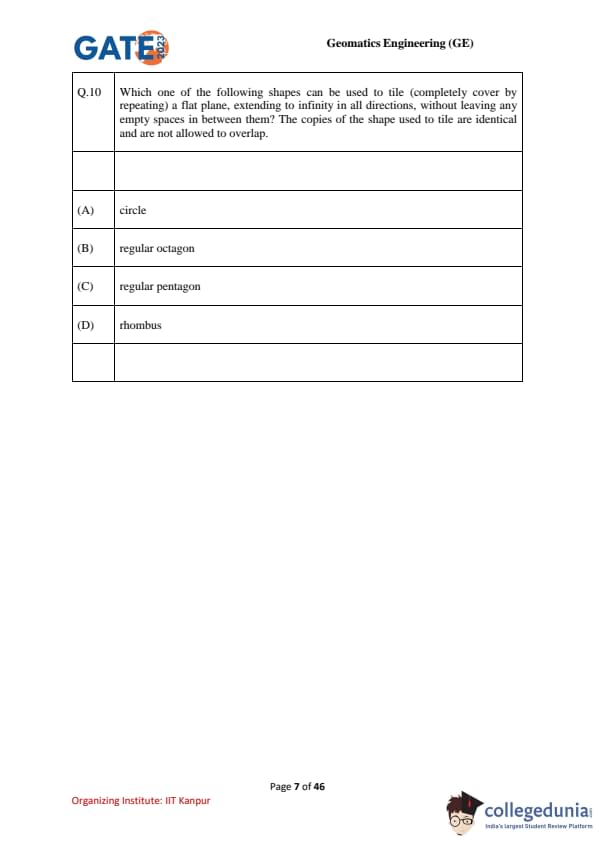
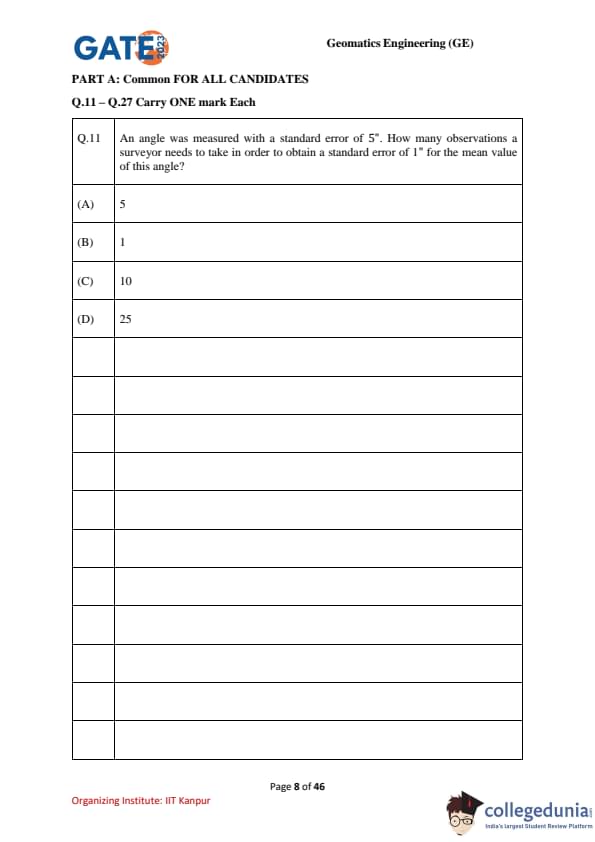
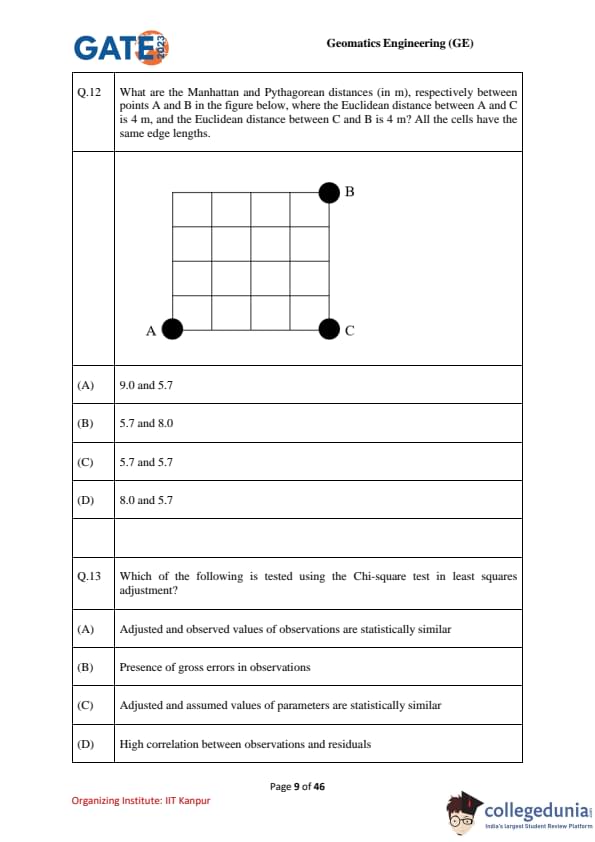


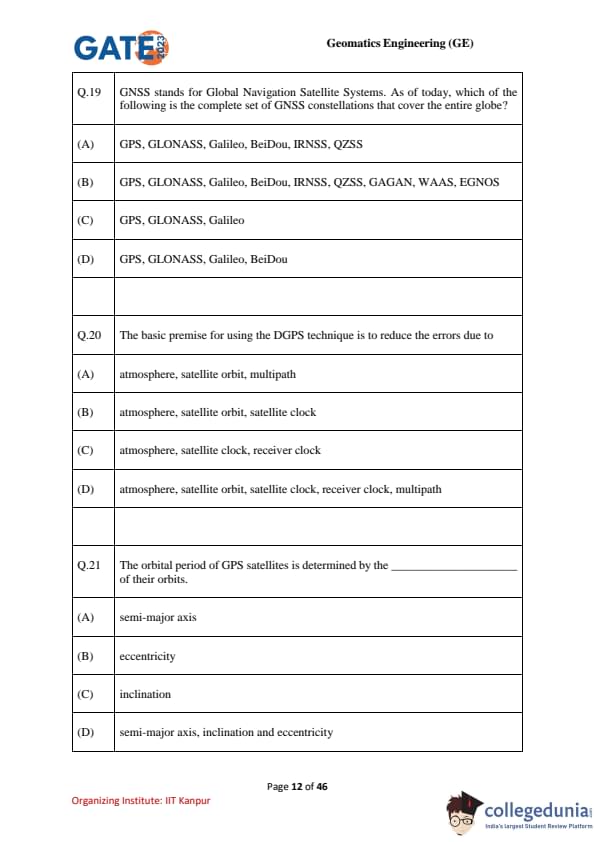

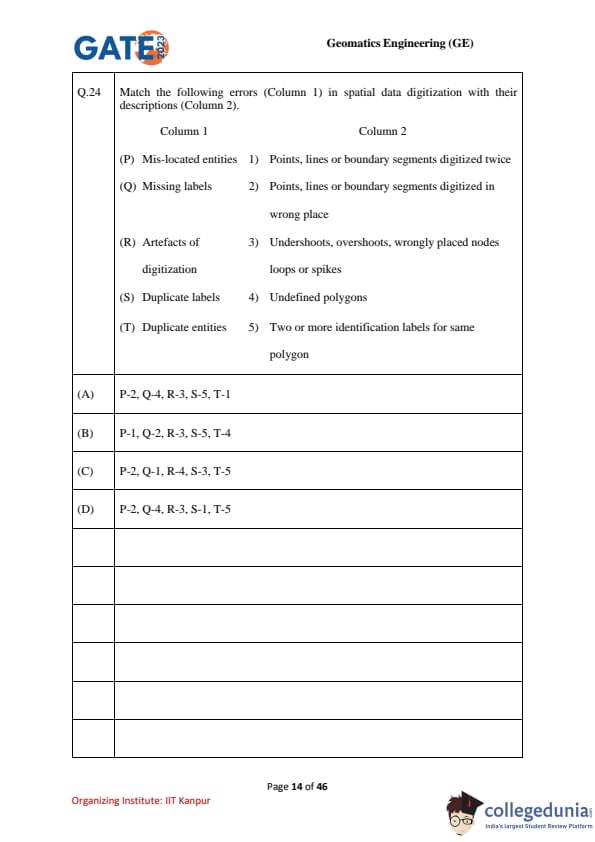



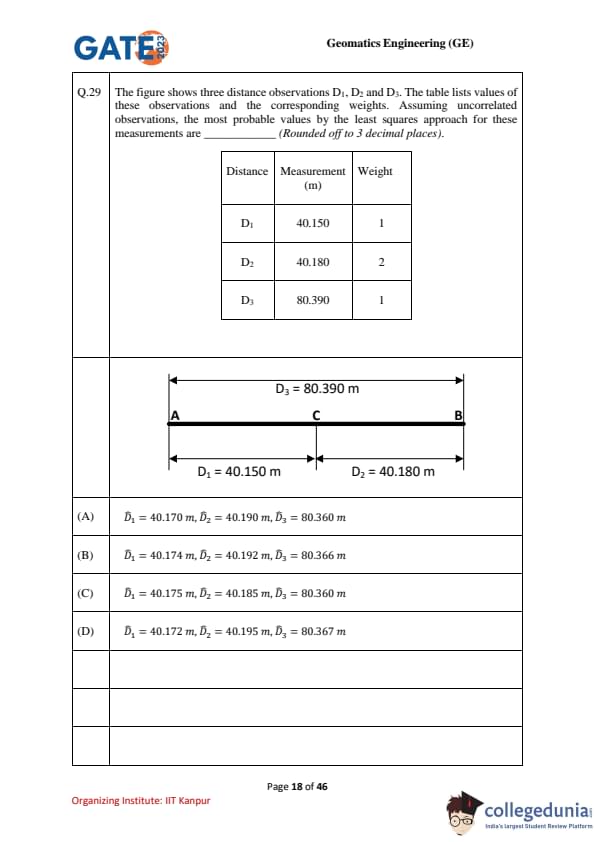
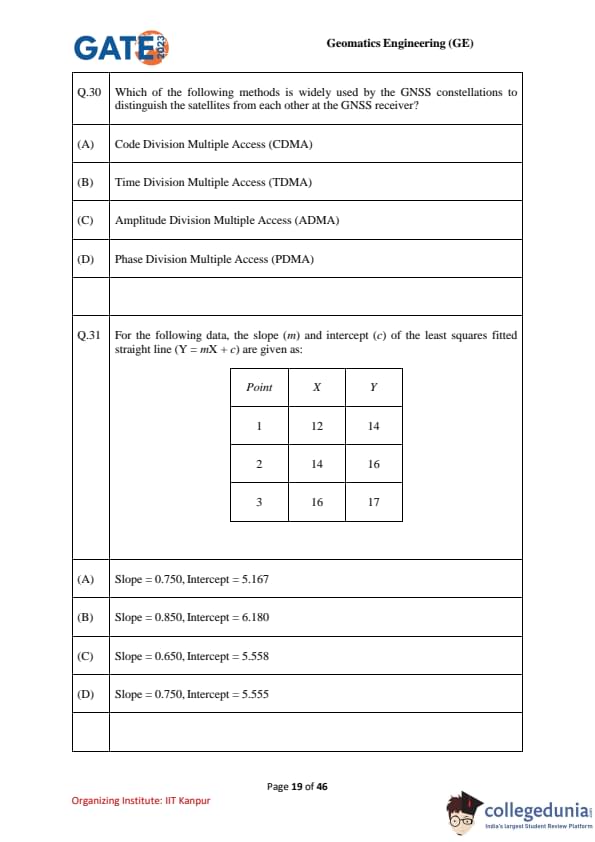
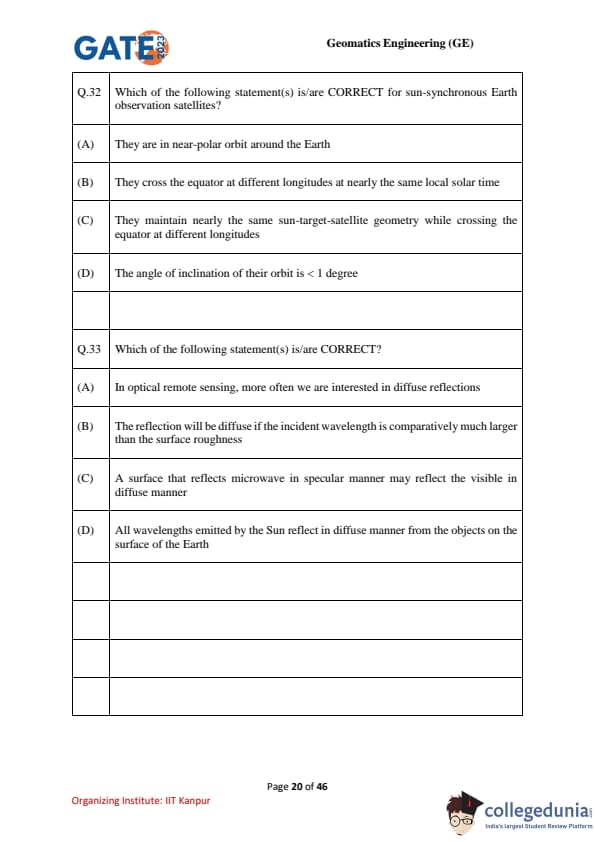

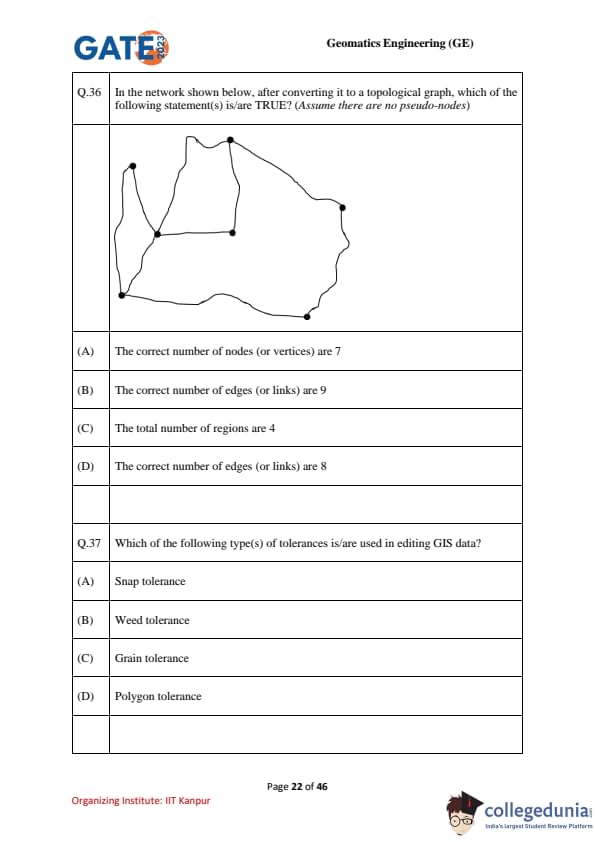

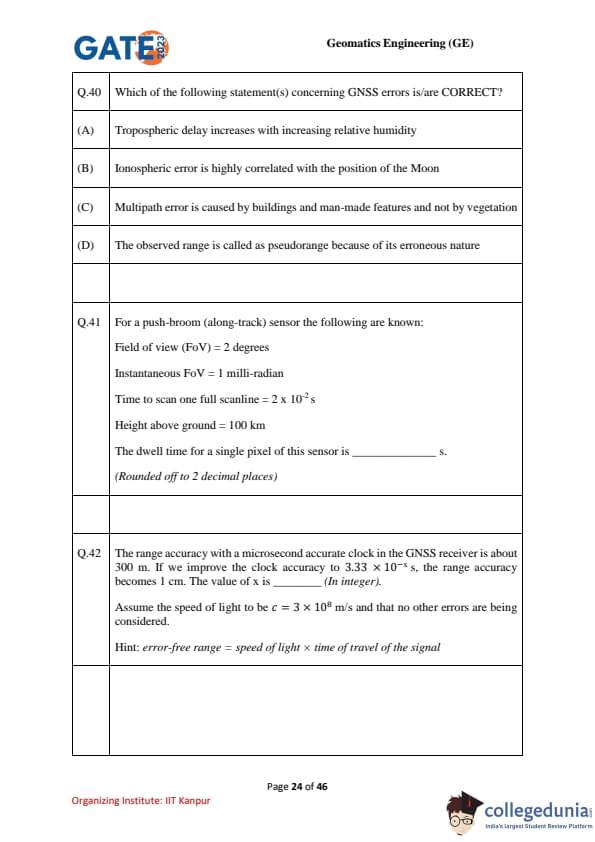
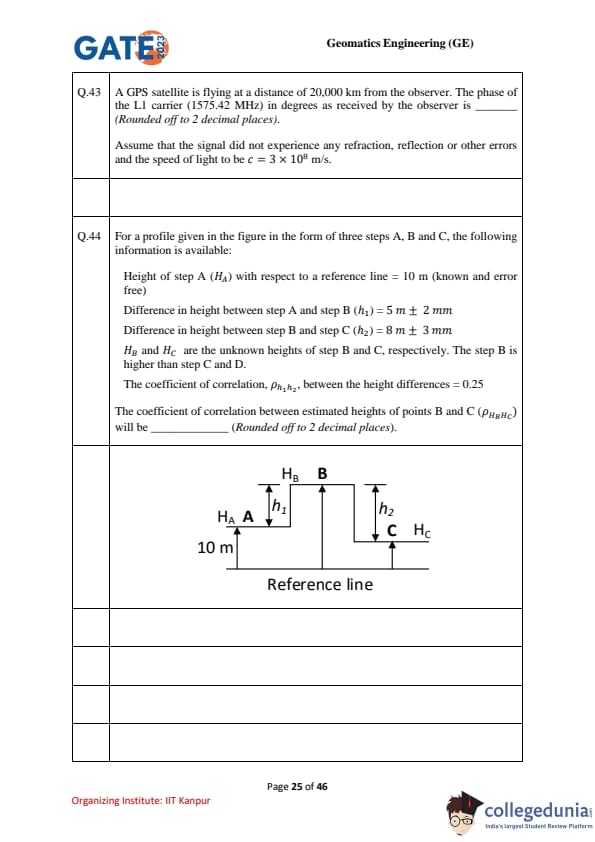

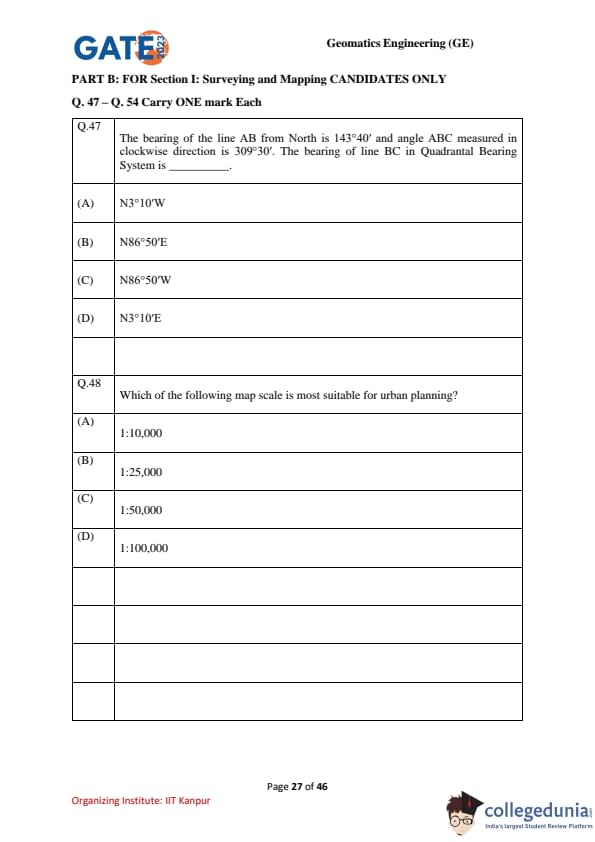

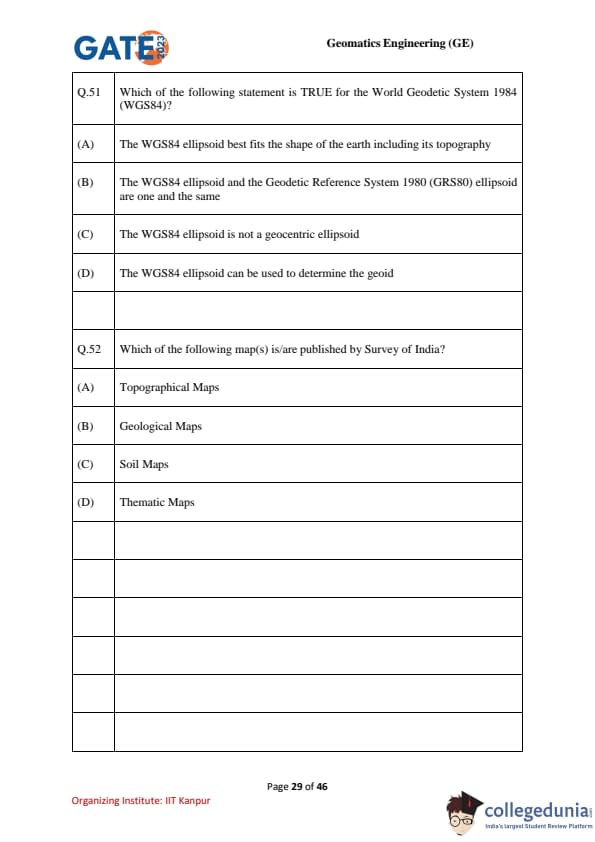
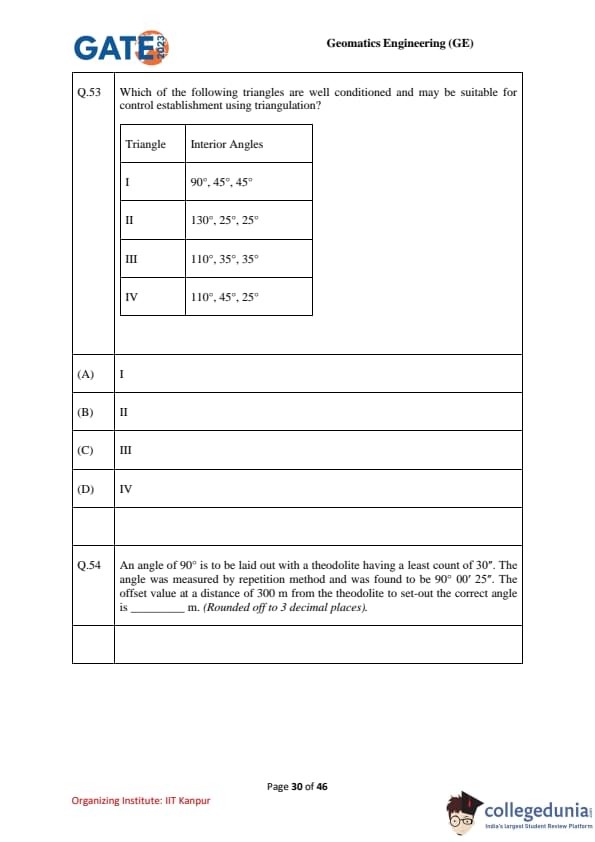



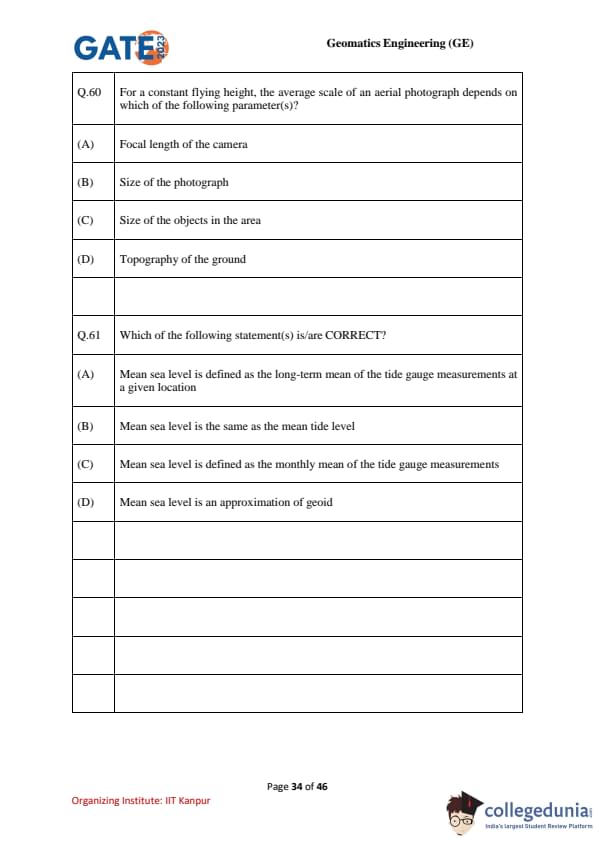
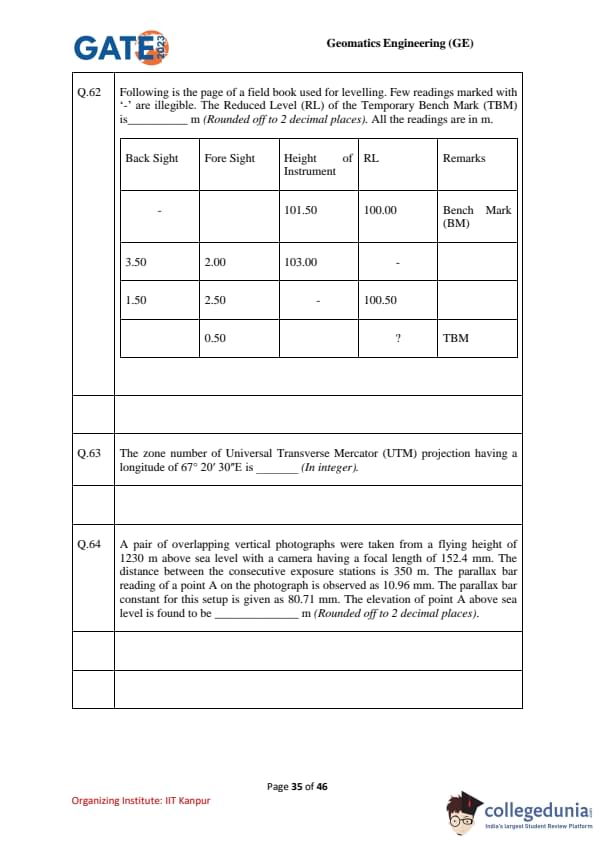
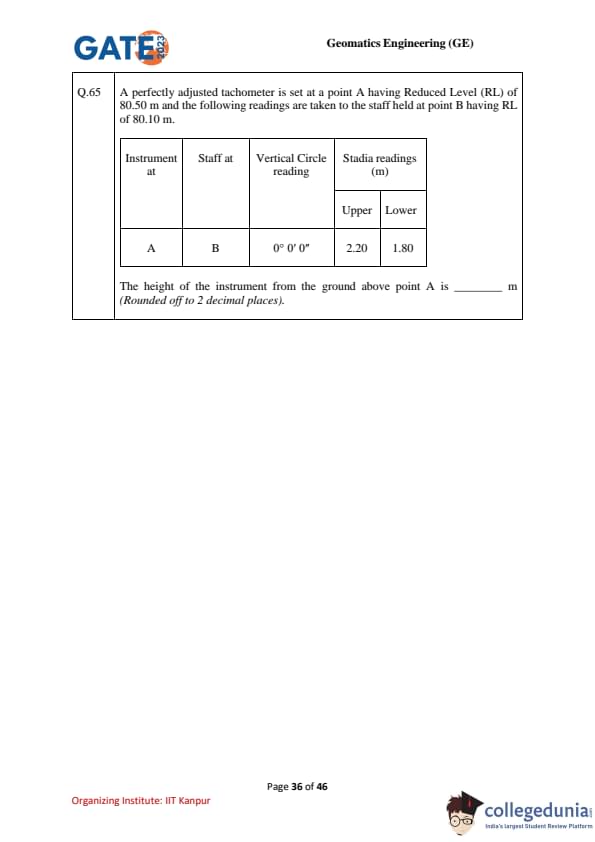

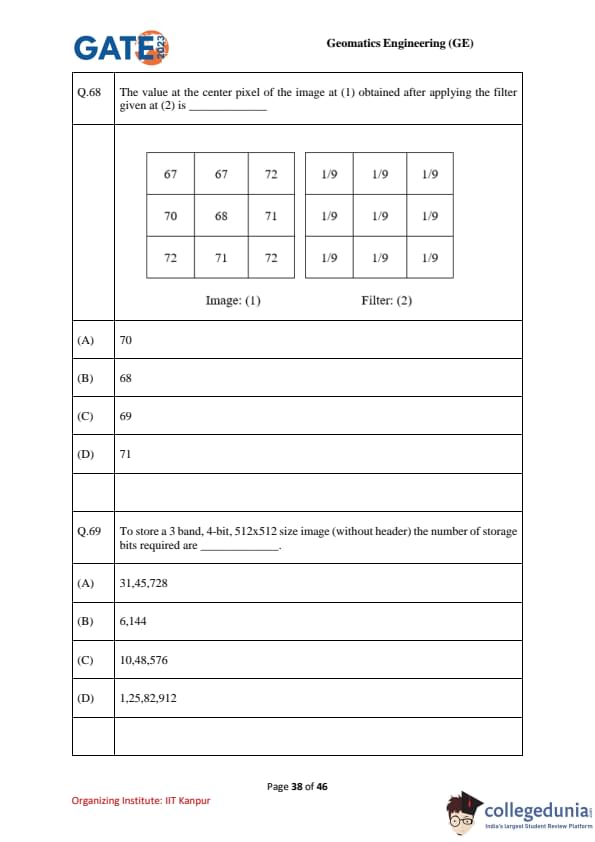

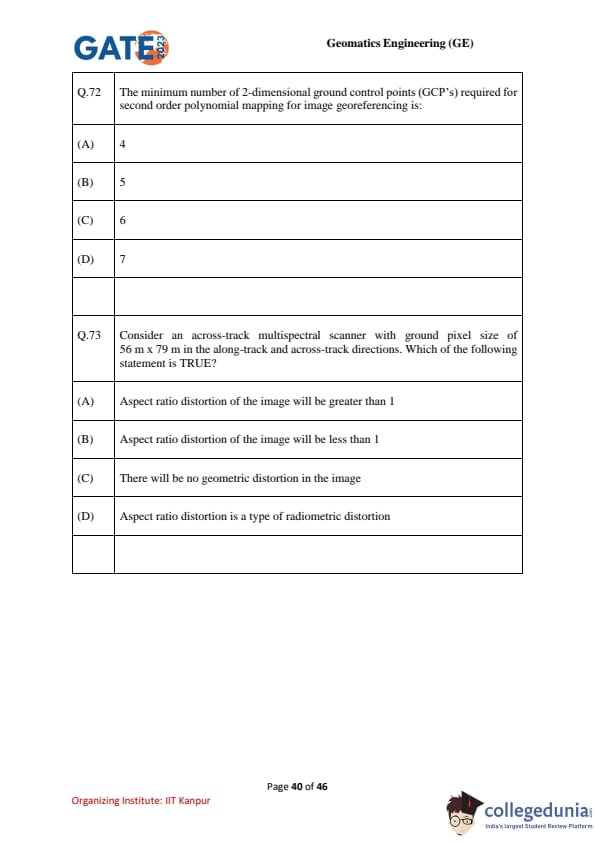
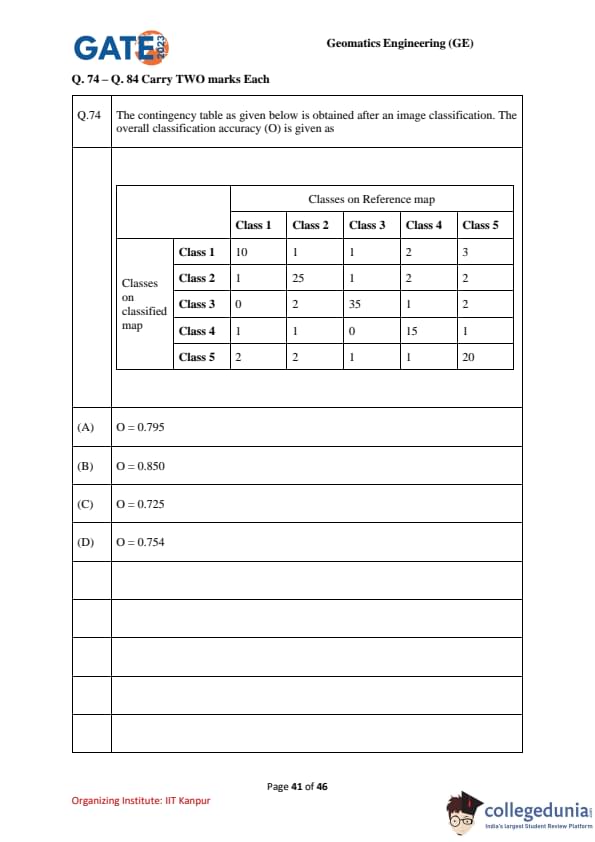
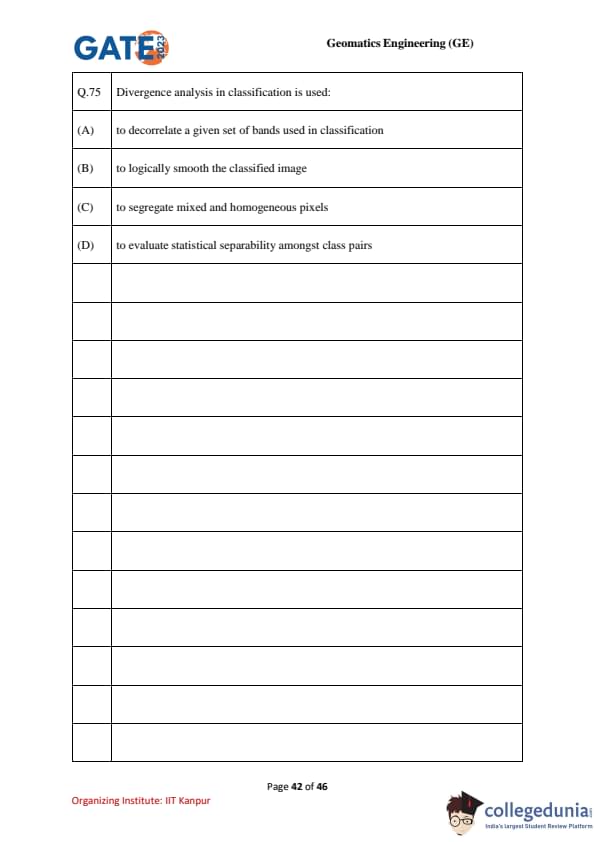



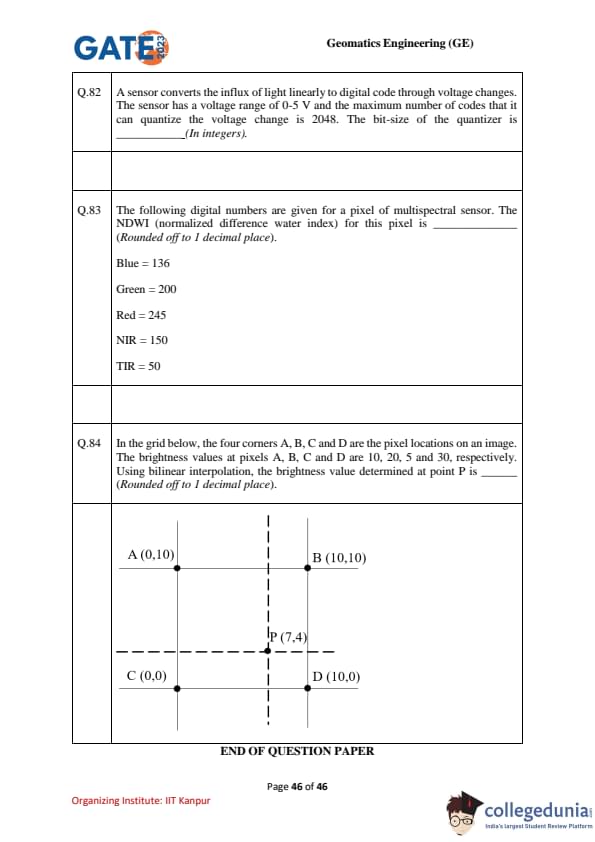
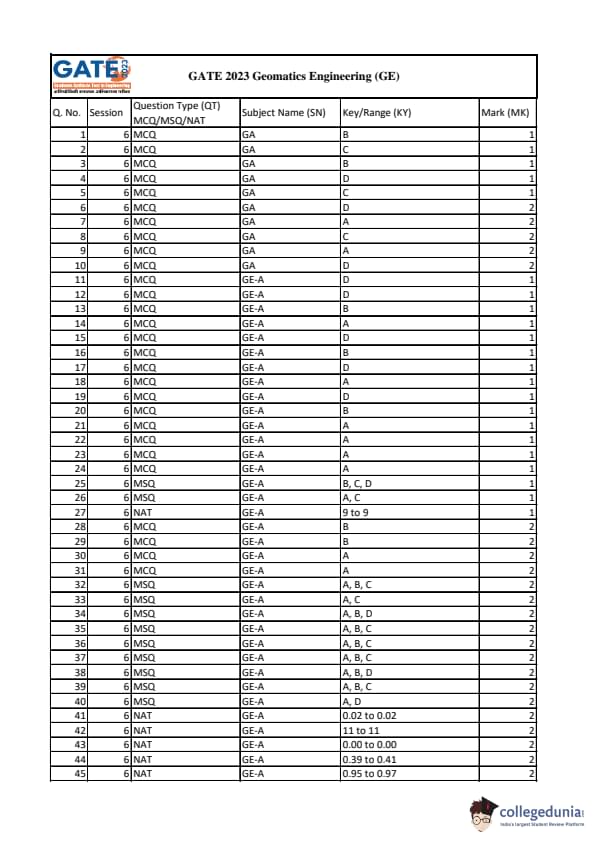

Also Check:
| Previous Year GATE Geomatics Engineering Question Papers | GATE 2023 Geomatics Engineering Paper Analysis |
| GATE Geomatics Engineering Exam Pattern | GATE Geomatics Engineering Syllabus |





Comments